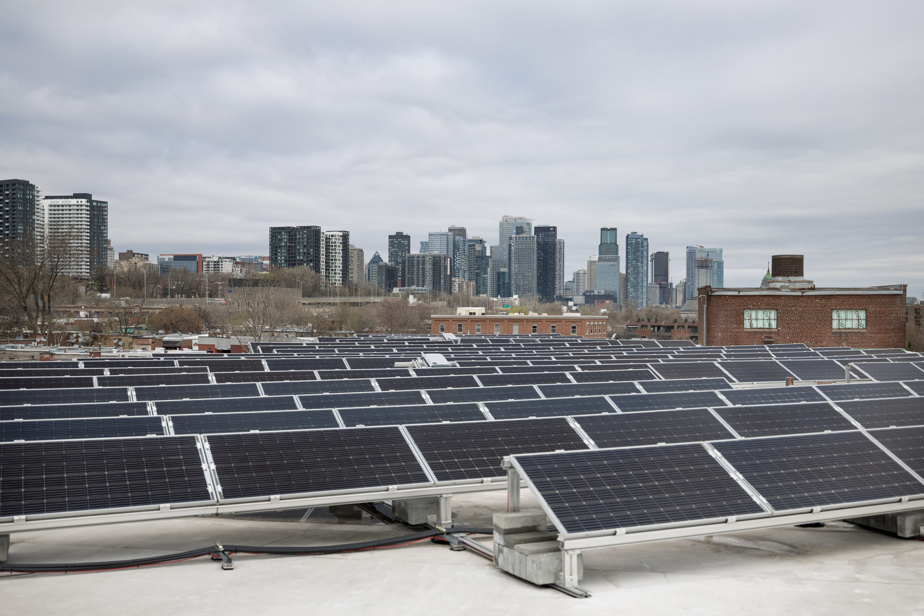Install solar panels to sell excess electricity to the network? For commercial, industrial or institutional buildings, the formula may seem attractive. It remains marginal in Quebec, in particular because of Hydro-Québec’s self-production criteria. The state company is working on an improved version.
“A few minutes before we spoke, we were producing more electricity than we were consuming,” Hugo Lafrance, partner, Sustainable Strategies, at the Lemay architecture firm, told us in an interview on April 9.
Despite the cloudy sky, the 370 panels installed at the company’s head office, in the Sud-Ouest borough, then generated small production surpluses, which were automatically sent to the Hydro-Québec network.
“So Lemay provided free electricity to Quebecers,” summarized Mr. Lafrance.
Hydro-Québec offers a net metering option for solar panel owners. When they send excess electricity to the grid, they receive credits applicable to their subsequent bills.
However, the power of their solar installation must not exceed 50 kW, almost three times less than a system like that of Lemay (135 kW) which does not meet current criteria.
“It’s a major obstacle,” underlines Mr. Lafrance.

PHOTO MARCO CAMPANOZZI, THE PRESS
Hugo Lafrance, partner, Sustainable Strategies at Lemay, in front of the solar panels on the roof of the architecture firm’s offices
Companies, when you tell them that they have to provide electricity, we understand them looking at you with a slightly sideways look, and not understanding why they would do that!
Hugo Lafrance, partner, Sustainable Strategies, of the architecture firm Lemay
Hydro-Québec’s net metering program, which is aimed at residential and agricultural customers, as well as small-power business customers, has fewer than 800 subscribers – a drop in the bucket among the approximately 4, 5 million customers in the province.
“As our needs will increase, we consider helping our customers to make greater room for self-production or solar self-consumption,” a Hydro spokesperson, Cendrix Bouchard, told us by email.
The state-owned company is “currently working on updating its net metering option,” Mr. Bouchard wrote, without further details. “We plan to submit our update proposal to the Régie de l’énergie this summer. »
In the meantime, Lemay has equipped itself with electrical and thermal storage systems to limit its “exports” of electricity to the network which, not being credited, represent “a net loss”. Its entire system provides “about a quarter of [la] annual consumption” of the company.
For the architecture firm, “it has almost become a research project to move things forward.” For companies and institutions interested in solar self-production, on the other hand, many obstacles remain.
Obviously, there are electricity rates, lower than elsewhere in Canada, which limit the savings potential. But that’s not all.
Read our report “The rise of solar in the land of oil”
When Lemay asked her district for a permit, she was told: “There are too many solar panels, people shouldn’t see them.” I’m talking to you about five or six years ago,” says Mr. Lafrance. He wants “a regulatory reform to tell cities [qu’elles ont la] responsibility not to harm the development of renewable energy.
The idea that an energy efficiency measure should pay for itself in a few years also does not encourage investment in solar, he notes.
“Lemay is 65 years old, and we still want to be there in 65 years, so 12 years for a return on investment is not far-fetched. »

PHOTO MARCO CAMPANOZZI, THE PRESS
The Lemay solar installation also provides the firm with electricity in the event of an outage.
The head of sustainable strategies also considers it “difficult to attribute a strictly financial value” to an investment like electrical storage.
When there are breakdowns, we don’t have to send 300 employees home, we can operate the building for a few hours on a zero-emission battery.
Hugo Lafrance, partner, Sustainable Strategies, of the architecture firm Lemay
The roofs of industrial buildings, and public buildings such as arenas and community centers, could accommodate many solar panels, underlines Mr. Lafrance.
“People are complaining about Hydro-Québec outages, we want to decarbonize more quickly, we don’t want to build dams. But magic doesn’t exist: we must give people the opportunity to use technical solutions that exist. »
Solar appeal
Hydro-Québec will soon launch calls for tenders totaling up to 300 megawatts of solar energy, starting with “small solar parks of a few megawatts,” Quebec announced at the end of March.
” Criteria […] are currently being developed and will be made public at launch [des appels d’offres]by the end of the year,” Hydro said.
The MRC of Pontiac, in Outaouais, is already preparing for it. Aware of the high solar potential of its neighboring territory of Ontario, the MRC published a call for interest to find developers with whom it could collaborate.
“It is above all support for adaptation and installation,” summarized Rachel Soar Flandé, economic development agent, in a telephone interview. “The role of the MRC in all this is to work with the promoter, especially on the social acceptability of the project, and possibly to help him in the search for sites. »
Property taxes, involvement of developers in the community, job creation and purchase of materials during construction: the establishment of solar parks would be interesting in several respects, believes the MRC.
The next step is planned for mid-May, when the MRC’s renewable energy committee will meet two of the promoters who have expressed interest.
Municipalities in the territory are also “considering” the installation of solar panels on their infrastructure to “reduce costs [d’électricité] and enjoy this sunshine.”
793
Number of customers owning solar panels registered in Hydro-Québec’s net metering in 2023. They injected a total of 1,812,406 kWh into the Hydro network.
Source: Hydro-Québec
